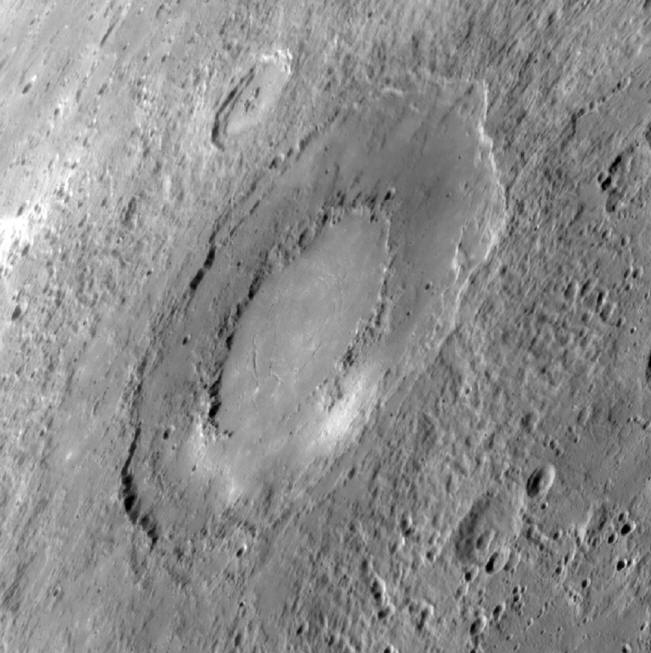|
|
|

Newly discovered multi-ringed basin on Mercury.
Credit: NASA and
Johns Hopkins University Applied Physics
Laboratory/Carnegie Institution of Washington
Final Flyby
Apr
29, 2010
(This TPOD
originally ran on Oct 01, 2009)
Yesterday, the MESSENGER
spacecraft flew close by Mercury in
preparation for a 2011 orbital
insertion.On August 3, 2004,
NASA launched the MErcury
Surface, Space ENvironment,
GEochemistry and Ranging (MESSENGER)
experiment from the Cape Canaveral
facility on a 7-year mission to
study the Sun's closest companion.
On January 14, 2008, MESSENGER
performed its first flyby of
Mercury, coming within 200
kilometers of the surface. The
spacecraft executed another close
order flyby, once more coming within
200 kilometers of the planet on
October 6, 2008. Its third flyby
maneuver on September 29, 2009,
provided MESSENGER with its last
gravity assist, essential for a
trajectory that will allow it to be
the first satellite of Mercury on
March 18, 2011.
Ordinarily, it would have only taken
a few weeks to send the MESSENGER
mission directly to Mercury. In
order to save fuel, thereby saving
launch weight, it had to follow a
path that included a flyby of Earth,
two flybys of Venus, and this last
of three flybys past Mercury.
Mercury is a relatively small
planet, 4878 kilometers in diameter.
Jupiter's moon Ganymede and Saturn's
moon Titan are both larger. Mercury
resides at a mean distance of
57,910,000 kilometers from the Sun,
so a year on Mercury lasts a mere 88
days. Since it rotates once every
58.6 days, the planet completes
three rotations for every two
orbits. Temperatures on Mercury can
reach a blazing 427° Celsius at
noon.
Mercury receives an average of
nine times more radiation at its
surface than the Earth, is bathed in
searing heat, and is bombarded by
charged particles from the Sun, so
how can it possess a thin but
detectable atmosphere?
This question is a conundrum for
planetary scientists—a planet with
such a weak gravity field (only 38%
of Earth), and under such intense
solar irradiation, should not retain
even the smallest remnant of an
atmosphere. The answer is that
Mercury is probably a relatively
young planet, perhaps as little as
10,000 years old, or younger. If
that is the case, then the presence
of an atmosphere is not surprising.
During the last MESSENGER flyby of
Mercury, electromagnetic flux tubes
were found, connecting the planet's
weak magnetic field directly to the
Sun with gigantic filaments of
electric current. In April of 2009,
NASA’s THEMIS satellites found
similar "electrical tornadoes" above
the Earth at the interface between
the magnetosphere and the ionic wind
from the Sun.
Known as Birkeland currents, they
are familiar to plasma physicists
and Electric Universe proponents. It
is those helical electrical
transmission lines that confine
plasma and allow electric currents
to flow over great distances. The
presence of electric currents
flowing like giant tornadoes into
Mercury hint at a time when those
currents might have been far more
powerful.
As mentioned in a Previous Picture
of the Day, there might have been a
period in Mercury's history when
those helical currents were
energized to the glow mode or the
arc mode stage. If that happened,
then the surface of Mercury would
have been the scene of gigantic
electric discharges blasting out
craters, cutting vast chasms, and
rearranging the atomic structure of
the planet's crust over large areas.
Multiple basins
found on Mercury, just as on
several other celestial bodies,
are probably formed when electricity
erodes material from the surface
where the arcs touch down. The pits
or craters left by electric arcs are
usually circular because the
electromagnetic forces constrain
them to strike at right angles to
the surface. If an electric arc is
composed of two filaments rotating
around a common center, the surface
will be excavated by a plasma "drill
bit," leaving steep sides and a
“pinched up” rim of debris. If
several filaments are involved, the
plasma beams will often cut one
crater within another, sometimes
with one or more smaller craters on
the rims.
Structures like the unnamed
multi-ringed basin shown at the top
of the page, as well as the altered
materials in the craters, could be
part of what has been left behind
after the increased electrical
energy through Mercury's structure
dissipated. Another example of
possible electric discharge activity
on the surface of Mercury is a
crater 110 kilometers in
diameter just seen by MESSENGER,
with an unusual curled trench carved
into its shallow, bowl-shaped floor.
How does the Electric Universe
hypothesis account for the volumes
of information returned by missions
such as MESSENGER? The Electric
Universe provides simple yet
surprising answers to that question
in such publications as, "Astronomical
Myths of Mercury and the Sun,"
by Wal Thornhill, and several
previous Picture of the Day
articles. When MESSENGER enters
orbit around Mercury, it is likely
that additional observations will
confirm our hypothesis.
Stephen Smith
|
|
|
|
|
|
|
|
|
YouTube video, first glimpses of Episode Two in the "Symbols of an Alien Sky"
series.
|
|
|
|
|
|
|
Three ebooks in the Universe Electric series are
now available. Consistently
praised for easily understandable text and exquisite graphics.
|
|
|
|
|
|
|
|
|
|







